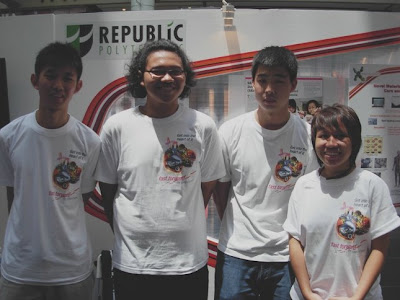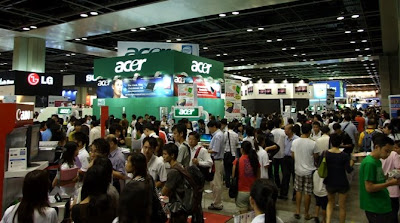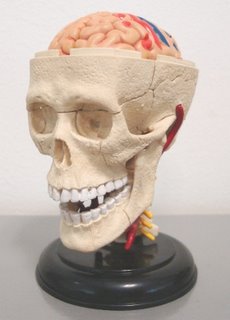
I was invited to the opening ceremony of the "
X-periment!" science carnival at Marina Square today.
This event kicks off the six-week-long "
science.08" festival comprising numerous fun activities throughout the island.
Boy do I have lots of photos for you!

When I first arrived, I was directed to the "media" desk where I was issued this nametag, a press kit, and allocated a seat together with real reporters behind the VIP row.
Wow, is this a sign that Fresh Brainz is finally legit?
Two long years ah... *sob*

Here's the MC for the event.
A model racetrack, which will later be used for the opening ceremony, occupies the centrestage.
The theme for this year's Science Month is "Fast Forward: The Science of Speed" - no doubt drawing an association with the
F1 motor race coming to Singapore in late September.

The welcome address was given by Dr. Chew Tuan Chiong, the head of the Singapore Science Centre.
He mentioned that Science Month was previously known as Tech Month, which had been around since the 1980's. That's interesting to know - obviously it wasn't so high profile back then, since I've never heard of Tech Month.
I first heard of this activity when they changed the name to Science Month in 2001. That was much better publicized.

Ms. Grace Fu, Senior Minister of State, Ministry of National Development and Ministry of Education, gave the opening address.
She noted that: "It is undeniable that science and technology has an impact on every aspect of our everyday lives. It dictates how we are living and how we will be living in the future."
I like the part of her speech where she encouraged our youths to be inquisitive about science.
Basic curiosity is critical to the sustainability of our scientific endeavour; world-class salaries can only get you so far.
The science carnival was then officially opened by Ms. Fu, Dr. Chew and Prof. Ren Ee Chee (Director, Graduate Affairs Office, A*STAR).
Dr. Chew and Prof. Ren drove two model racecars around the tracks by remote control, and when their "friendly race" concluded, balloons and confetti showered from the ceiling.
Let the festivities begin!

The opening performance was given by
Rhys Thomas, an American juggler-stand up comic-physics educator.
Apparently he's been doing this for over 20 years.
He is good.

Here, Rhys demonstrates gyroscopic stability to the audience.
When you spin a funnel, it's easier to balance it on your palm.
A static funnel would simply tip over.
"It's unstable - just like my income!" he says.
Nice.

Now Rhys begins to juggle five plastic rings.
He reveals an insider trick: the rings are spun just before they are released, so that they will follow a more predictable path.

Next he moves on to the Chinese yo-yo (or
Diabolo).
Man, he's a maestro of spinny things.
And I love the word "diabolo". It totally sounds like something else that is utterly evil and twisted.
Of course "diabolo" has as much to do with the diabolic as "
titular" has to do with tits.
 Cat's cradle!
Cat's cradle!Without noticing it, Rhys forms a pattern that resembles the "X" on the X-periment logo behind him.
I believe that in the photography business, they call this "juXtapositioning".
Again it has nothing to do with jugs.

Finally he attempts to keep nine bowls on sticks all spinning at the same time.
"Don't worry about the bowls - they're not mine."
Funny guy.
Don't miss his entertaining performance - scroll down to the end of this post for a detailed schedule.

Before I talk about the exhibition itself, let me focus your attention on the decorative signs that are attached to the ceiling. They indicate the speeds of well-known things like cheetahs and space shuttles.
Here's one that reads: "Speed of a free falling human being: 200 km/h"
I don't know if it's the words or the skyscrapers in the background, but I find the sign tragically funny.
"Free falling human being" sounds so... sad.
Don't be a free falling human being.
Be a skydiver!

Notice that people may fall at
around 200 km/h, but sharks swim at
exactly 69 km/h.
Not 70 km/h or 68 km/h, mind you.
Of all the speeds in the known Universe, it has to be 69.
I love sharks.

OK, back to the exhibition.
This is the F1 racing simulator set up by Nanyang Polytechnic. Ms. Grace Fu was briefed on how to drive the simulator while the ever-present mainstream media snapped away.
Fresh Brainz will always be more awesome than the mainstream media.
Do you know why?
It's because, umm... because... we are more inquisitive. That's right.
We're funnier because we ask the sort of questions that YOU would ask.
Questions like: "Can you polish a black shoe so shiny that it is no longer black?"
Ok maybe not
that sort of questions.

Next, Ms. Fu visits the National University of Singapore booth featuring "Air-Mix" - an interactive music interface that allows you to jam with the melody, bass and drum tracks by moving a set of printed discs in front of a camera.
Be a VJ!

Here's a kid and his mummy who look like they are having fun with the Air-Mix.
In order to engage the public, an intuitive hands-on interface like this is definitely helpful.
Since this is an NUS booth, I'll be coming back to support the guys after my initial tour of the exhibition.
More on that later.

Ever wondered where rainbows come from?
Here's a volunteer from the Data Storage Institute using reflected sunlight and a water spray to create a short section of rainbow just above the booth - I've increased the contrast so that you can see it better.

Speaking of rainbows, here's a plethora of colours revealed by a set of polarizing filters. Scientists use these to study the stress patterns in transparent materials.
You can see a nick on the mouth of the plastic cup - it could be a weak point in the cup, but all the other cups seem to have it too. Perhaps it shows us how the cups were manufactured.
Polarized light seems so "physics" but biologists use it too.
I'll come to that later.

And now... a demonstration of the effects of liquid nitrogen by
Colonel Uri Abusikov!
Ursula, can you bring me the liquid nitrogen?
Thank you, my love.
Erm, actually it isn't Abusikov doing the demonstration, but a young Nanyang Technological University volunteer.
Which unfortunate object will be dunked into liquid nitrogen today?

It's a
banana hammer!
*gasp*
A banana frozen solid by liquid nitrogen is hard enough to drive nails into a wooden plank.
*thunk thunk thunk*
Looks painful...

*PIAK!*
Aiyeeeeeeee! That's so wrong... snapping it into two...
I should mention that the volunteer only broke the banana because a mainstream media videographer insisted that he should break it for dramatic effect.
Fresh Brainz would have been much kinder to hapless bananas.
Someone bring me a mallet!

Since it is already broken, let's take a look at the cross-section of the banana.
What a clean break!
Indeed, in real life scientific research, liquid nitrogen is used to help make biological samples hard enough to be cut into very thin sections and examined under a microscope.
Liquid nitrogen - it's a miracle!

Also at the NTU booth is this demonstration of popping a balloon under water to watch the effects in super slow-motion.
I don't know what's it with water, balloons and high-speed cameras - they always seem to go together.
In my humble opinion, there is
one more element that would make this demonstration even more compelling.

Hey, here's Mr. Thomas again.
Although there's still some time before his next performance, he's already hard at work teaching kids how to balance a spinning ball.

And so I move on to the Republic Polytechnic booth, staffed by these young enthusiastic volunteers.
Show me da goods!

Wha... it's not about breaking stuff again, I hope?
Luckily, their project is about developing composite materials that have self-healing properties. Such materials can be potentially used in parts of cars and aircraft which are subject to high stresses.
Here's a piece of plastic with embedded glass capillaries inside which separately contain two liquid constituents of epoxy glue.
If the material snaps into two, the capillaries break and the glue components pour out - mixing together to form a solid seal between the two broken parts.
Neat.

And these are the individual glass capillaries, seen close-up.
They look so arty!

I can't resist slipping a bit of biology into this post.
At the Institute of Molecular and Cell Biology booth,
Prof. Vladimir Korzh is demonstrating the use of polarized light to examine zebrafish embryos. It's possible to do this because zebrafish embryos are transparent for much of their early development.
These appear to be 24-hour stage embryos, seen through the microscope. There is obvious vignetting here because I took this picture right through the eyepiece.
The embryos are still alive - you can see their tiny hearts beating!
Using this standard bright field technique, you can't see which part of the embryo is made of muscle...

However, once you use the polarizing filters, the muscles stand out as a bright streaks.
This makes it easier to study the size and shape of the muscle groups in zebrafish, especially when evaluating the effects of muscle-related genes.

Here are some colourful transgenic zebrafish in a tank, swimming too fast for me to capture a clear shot.
Prof. Korzh pointed out that the noisy environment in the shopping mall is probably making the fish more agitated than normal.
Fish use their
lateral line to detect sounds and movement. This is homologous to the inner ear of mammals such as human beings; both structures are made up of a similar type of cells.

How can a science carnival be complete without
robots?
This is a "social robot" that can understand speech, recognize objects, pick them up gently and navigate its own way around a room.
So why is it sitting there and staring blankly at a tennis ball?

When a robot seems disturbingly still, you must look at its eyes very cautiously.
If it
suddenly glows red - don't fuck around.
Run like hell!

Oh silly me... the social robot wasn't thinking about Sarah Connor; it was motionless because the programmers were having some problems with its camera and they were trying to recalibrate it.
Remember kids - If there's no troubleshooting involved, it isn't science!
Dr. Tan Yeow Kee from the
Institute for Infocomm Research is part of the team who developed this robot. He noted that the software created for this robot can have wider applications in a variety of interactive devices.
He speculates that as Singapore faces an aging population, machines that can understand speech and help take care of the elderly will become more common in the marketplace. This is already happening in Japan today.
OK, now time for a quiz!
I mentioned sharks earlier.
Sharks are cool animals.
But what is way cooler than a shark?

A shark with
a frickin' laser beam on its frickin' head, why of course!
Here's a green laser source used at the Institute of Microelectronics booth. Although it is quite large (more than 30 cm long), at 1.5 mW it isn't particularly powerful.
In fact it is even weaker than my 5 mW green laser pointer. Perhaps research lasers don't need to be very powerful, but must be more accurate than consumer lasers.

This laser is used for analyzing the surface structure of a type of manufactured crystal known as
photonic crystals.
The green beam is first reflected and shaped by a series of mirrors and lenses.

Then the beam is broadened and directed through two barriers that result in a donut-shaped beam of light.

Finally the laser beam is focused into a tiny spot onto the photonic crystal itself. You can see the green laser spot on one of the squares in this picture.

Due to the regular structure of the photonic crystal, the laser is diffracted into six separate beams of light.
You can see this by putting a cardboard box just in front of the sample to "catch" the diffracted rays.
By analyzing these rays, scientists can deduce the surface structure of the crystal without requiring expensive direct methods like electron microscopy.

Finally - one last booth by the Institute of Chemical and Engineering Sciences.
Truth be told I've never been a fan of chemical equations.
Is this some important chemical process commonly used in large-scale industries today?

No, actually it just describes a bizarre colour-changing reaction that oscillates back and forth.
It's formally called the
Belousov-Zhabotinskii Reaction.
What a mouthful.
The liquid gradually turns from blue to reddish-purple and then suddenly to green and slowly back to blue again. Looks quite cute.
When I asked the demonstrator about the potential applications of this reaction, she just smiled and stated that there weren't any.
Ah... science for the sake of pure curiosity!

Time to head back to the NUS booth and support our plucky volunteers. Here are five of them showing off their temporary tattoos.
Aside from the Air-Mix, they have also created an SMS poetry generator that takes the first line of your SMS text and turns it into a poem.
So I typed "Come Support NUS ah!"...

... and this is the result.
It sorta makes sense.
Come support - do not delay!

Oooh it's time for another show by Rhys Thomas!
He's back on stage teaching a whole bunch of kids how to balance spinning balls on their fingertips.
If you're not busy with other activities this weekend, why not come down to Marina Square to check out his rib-tickling performance?
Here's the schedule:
Rhys Thomas' "Science Circus"
16 August (Saturday)
12 noon, 2.30pm, 4.30pm, 7.30pm.
17 August (Sunday)
12 noon, 2.30pm, 4.30pm.Two more days only, somemore it's free, so don't shy-shy - come and enjoy ah!
Would you like to know more?
- About science.08
 I went to the Republic of Singapore Air Force (RSAF) Open House yesterday - mainly to visit my brother who is on duty there, but also get a bunch of nice photos for you guys.
I went to the Republic of Singapore Air Force (RSAF) Open House yesterday - mainly to visit my brother who is on duty there, but also get a bunch of nice photos for you guys.












 Just sneaked a peek at the
Just sneaked a peek at the 
























 There is an ongoing discussion at The Online Citizen about alternative medicine and autism entitled "A Straits Times campaign against alternative therapies?"
There is an ongoing discussion at The Online Citizen about alternative medicine and autism entitled "A Straits Times campaign against alternative therapies?" Do you like Star Wars?
Do you like Star Wars? Here's a live demonstration of how unfunny comic strips actually are:
Here's a live demonstration of how unfunny comic strips actually are: I was invited to the opening ceremony of the "
I was invited to the opening ceremony of the "












































